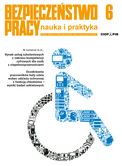Reduction of muscle load being the result of repetitive work – review of research on organizational solutions
Patrycja Łach
Repetitive work is common in many branches of the industry. Repeating the sequence of movements involve only selected group of muscles, which leads to an increase of workload. Muscles overload in an important determinant of the development upper limb disorders. It is therefore important to identify the factors increasing the level of load and try to limit their impact by a well-designed workstation and work time organization.
The article presents an overview of research on organization solutions on repetitive workplaces, which aim improvement working conditions and minimizing the risk of development of musculoskeletal disorders.
Viruses as harmful biological agents in the office work environment
Agata Stobnicka, Rafał L. Górny
Exposure to viruses is an important, but often neglected, occupational hazard of office workers.
Ventilation (including air-conditioning) systems, contaminated surfaces as well as direct contact with sick
workmates are some of the major emission sources of these harmful biological agents. Due to the small
amount of data on exposure to viruses in the offices, the risk assessment in this occupational environment,
if carried out at all, usually neglects this group of microbiological agents, focusing on bacterial and fungal contaminants
only. This approach seems to be incomplete and should be supplemented by an assessment of exposure to viruses,
too.
Model of the wireless monitoring of noise and vibration in the working environment’s system
Leszek Morzyński, Grzegorz Szczepański
Vibroacoustic harmful factors, namely noise and vibration, are common in the working environment, contributing to the formation of occupational diseases. Taking preventive measures to protect workers from exposure to excessive noise or vibration requires knowledge of the state of hazards in the workplace. This can be gained utilizing systems for monitoring noise and vibration in the working environment.
The paper presents the system’s model developed in CIOP-PIB, which is a wireless sensor network for monitoring noise and vibration hazards. In the abovementioned model renewable energy sources are used for powering noise and vibration meters. This solution increases the autonomy of the meters and reduces the cost of the system maintenance. The article describes the main principles and concepts of the system, discusses the construction of a model of the system and provides examples of the results of measurements taken with its use. Summary presentation of results from the central receiving signals from several or even more sources will be a matter of future publications.
Work–life balance in the opinion of employees
Katarzyna Hildt-Ciupińska
Today we live very quickly. Thanks to many advanced technologies, we can almost constantly be at work. In these circumstances, the most important challenge is to find an optimal balance between work and life (family, home, private life). A work–life balance is nowadays a topic of many scientific papers, social debates and discussions. This popularity of the subject is triggered by the lack of work–life balance among the workforce. This paper presents the results of a survey on the perception of the work–life balance by employees and recommendations on how those two domains of our lives can be reconciled.
Safety of exploitation of heat pumps and refrigeration devices – in regard of its operators and the environment
Wojciech Tuchowski
The article is a continuation of the problem of exploitation of refrigeration and heat pumps. In the second part of the article shows the procedure leak detection and recovery of refrigerant in a refrigeration system and the air conditioning using devices designed for this purpose. Identified opportunities to reduce emissions of refrigerants and reduce the size of the index TEWI analyzed for water source heat pump system. It estimated the value of the TEWI index for different sizes emissivity factor β [kgCO2 / kWh].





























